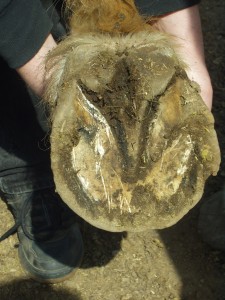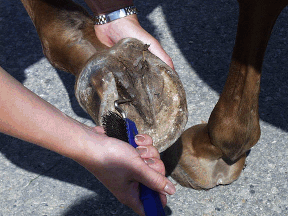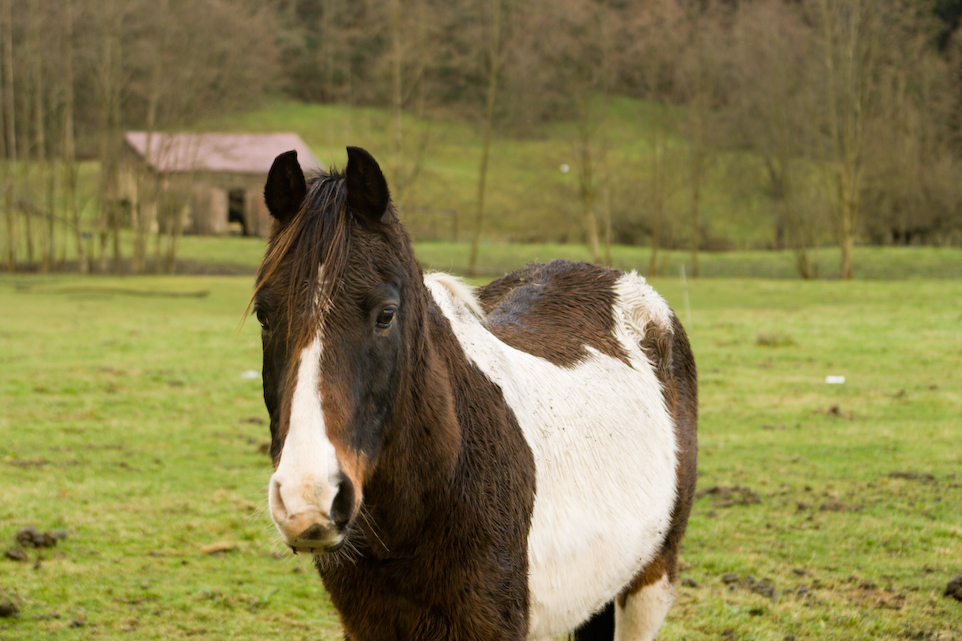 In horses, when we speak of thrush we are referring to a bacterial and sometimes fungal infection in the hoof (specifically the associated bacteria is called Fusobacterium necrophorum). This bacteria is the same one that is associated with footrot in cattle and sheep, and it lives in the ground. It is untrue that thrush always results from horses being kept in dirty conditions. It is usually the case that it results from impairment of the hoof's self-cleaning mechanisms.
In horses, when we speak of thrush we are referring to a bacterial and sometimes fungal infection in the hoof (specifically the associated bacteria is called Fusobacterium necrophorum). This bacteria is the same one that is associated with footrot in cattle and sheep, and it lives in the ground. It is untrue that thrush always results from horses being kept in dirty conditions. It is usually the case that it results from impairment of the hoof's self-cleaning mechanisms.
Causes
Thrush usually results from the frog, sulci (crevices on either side of the frog) and surrounding structures being unable to self-clean. This involves the sole flattening and the frog expanding. This mechanism can be disrupted for a few reasons:
- If the hoof is of abnormal shape from growing incorrectly, poor/absent farriery, or has been damaged, then this can disrupt the self-cleaning mechanism.
- If the horse has had a poor diet, insufficient exercise, or lameness issues, then this can also affect the mechanism of the hoof's undercarriage, and thus prevent self-cleaning
- If a horse is confined for long periods of time to a stall or paddock, and is not moving about and expanding their frog, then they are also at risk
- During periods of constant wet weather you may be unable to prevent your horse from standing in mud, and thus the sulci are not kept clean.
- Draught horses are at particular risk because they often have deep sulci which may not self-clean as effectively as other breeds
Symptoms
- Black, dead material on and around frog, usually found in the sulci
- May smell purulent
- Parts of the frog may slough off
- Horse may be lame in severe cases
Diagnosis
Diagnosis of thrush usually results from a visual examination by either your vet or farrier. In fact most experienced farriers can detect and treat thrush, especially the milder cases.
 Treatment
Treatment
Thrush can be difficult to eradicate. Ideally the affected areas of frog would be pared away to leave an uncontaminated structure. Sometimes this can result in small amounts of bleeding which can make your horse sore. Also it is difficult to detect how deeply the frog had been contaminated.
In many cases topical treatment is opted for, but unfortunately there is no definitive treatment that will work for every horse every time. Some aim to kill the bacteria and fungi with bleach, iodine solutions, metronidozole, or washes such as Malaseb to name a few. You can buy commercial products that specifically target thrush and many are effective, but there's no particular one we could say worked every time on every patient.
In severe cases antibiotics may need to be administered, and in this instance your vet may recommend sending a culture to the lab to attempt to identify which bacteria is affecting the hoof. Unfortunately this does not always give us a definitive answer. Corrective farriery and shoeing may be recommended to support the damaged structures.
Prognosis
If your horse's case is mild and they receive prompt and appropriate treatment, then it is very likely the thrush can be eradicated and your horse will go on to have no issues from that instance of infection. Obviously if the conditions which led to the initial infection are still present, then thrush may reoccur.
 If your horse's case is severe, and the thrush moves up into the deeper structures of the foot, then in some cases permanent lameness may result (even with timely and appropriate veterinary treatment).
If your horse's case is severe, and the thrush moves up into the deeper structures of the foot, then in some cases permanent lameness may result (even with timely and appropriate veterinary treatment).
Prevention
There are a few things you can do to lower your horse's risk of developing thrush:
- Ensure your horse receives adequate turnout time and exercise to increase the hoof's time to self-clean
- Have an experienced farrier trim your horses feet regularly to keep good shape
- Ideally keep your horse somewhere they are able to get out of the mud in wet weather, although we do understand with the recent summer rains this is not always possible
- Do clean out your horses feet regularly, but ensure you are not overly enthusiastic and damage the frog or sulci. This may create an entry point for the bacteria to get in and create infection
- Keep an eye on the frog and sulci, especially in draught horses, and call your farrier or vet if symptoms appear
Back to Horses










